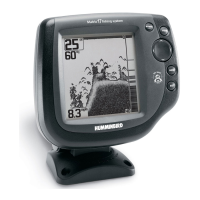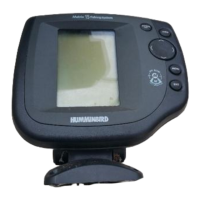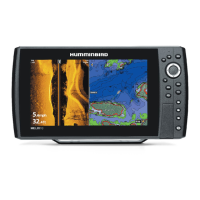Do you have a question about the Humminbird Matrix 27 and is the answer not in the manual?
Details the 200 kHz single beam sonar system and its coverage area for specific models.
Explains the 200/83 kHz DualBeam PLUS™ sonar system and its wide coverage area.
Describes the QuadraBeam® sonar system with its 90° coverage and side structure locating beams.
Presents a historical log of sonar returns, showing depth, temperature, and speed if available.
Explains how the display represents sonar data as a historical log, not a 3D representation.
Shows sonar returns at the fastest rate possible, displaying bottom, structure, and fish within the beam.
Increases display resolution to separate sonar returns that are close together, showing a magnified image.
Displays sonar returns from 83 kHz and 200 kHz beams side-by-side for comparison.
Provides digital data in a large, easy-to-see format for depth, temperature, speed, and Triplog.
Shows sonar information from left and right 90° 455 kHz beams and the 200 kHz down-looking beam.
Charts depth changes to create a bottom contour profile and determines bottom type from sonar returns.
Explains how to turn the unit on/off and adjust backlight and contrast settings.
Describes how to cycle through available display views using the VIEW key.
Details how to access the menu system, including Start-Up, X-Press, and Main Menus.
Explains how to use the cursor keys for menu navigation and selection.
Covers the various functions of the EXIT key, such as canceling alarms and exiting menus.
Allows selection of operating modes like Normal, Simulator, System Status, or PC Connect.
Provides quick access to frequently used settings like Sensitivity, Range, and Chart Speed.
Covers sonar-specific settings including Beam Select, Fish ID+, and sensitivity adjustments.
Allows setting up alarms for depth, fish identification, and low battery voltage.
Enables configuration of units, user mode, language, and other system preferences.
Addresses common problems like the unit not powering up or defaulting to simulator mode.
Guides on fixing display issues, weak readings, and identifying sources of electrical noise.
Provides guidance on identifying and resolving sources of electrical noise and interference.
Guides on how to turn on the unit and select start-up options.
Explains how to connect accessories to expand system functionality.
Details the 200 kHz single beam sonar system and its coverage area for specific models.
Explains the 200/83 kHz DualBeam PLUS™ sonar system and its wide coverage area.
Describes the QuadraBeam® sonar system with its 90° coverage and side structure locating beams.
Presents a historical log of sonar returns, showing depth, temperature, and speed if available.
Explains how the display represents sonar data as a historical log, not a 3D representation.
Shows sonar returns at the fastest rate possible, displaying bottom, structure, and fish within the beam.
Increases display resolution to separate sonar returns that are close together, showing a magnified image.
Displays sonar returns from 83 kHz and 200 kHz beams side-by-side for comparison.
Provides digital data in a large, easy-to-see format for depth, temperature, speed, and Triplog.
Shows sonar information from left and right 90° 455 kHz beams and the 200 kHz down-looking beam.
Charts depth changes to create a bottom contour profile and determines bottom type from sonar returns.
Explains how to turn the unit on/off and adjust backlight and contrast settings.
Describes how to cycle through available display views using the VIEW key.
Details how to access the menu system, including Start-Up, X-Press, and Main Menus.
Explains how to use the cursor keys for menu navigation and selection.
Covers the various functions of the EXIT key, such as canceling alarms and exiting menus.
Allows selection of operating modes like Normal, Simulator, System Status, or PC Connect.
Provides quick access to frequently used settings like Sensitivity, Range, and Chart Speed.
Covers sonar-specific settings including Beam Select, Fish ID+, and sensitivity adjustments.
Allows setting up alarms for depth, fish identification, and low battery voltage.
Enables configuration of units, user mode, language, and other system preferences.
Addresses common problems like the unit not powering up or defaulting to simulator mode.
Guides on fixing display issues, weak readings, and identifying sources of electrical noise.
Provides guidance on identifying and resolving sources of electrical noise and interference.
Guides on how to turn on the unit and select start-up options.
Explains how to connect accessories to expand system functionality.
| Brand | Humminbird |
|---|---|
| Model | Matrix 27 |
| Category | Fish Finder |
| Language | English |











